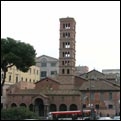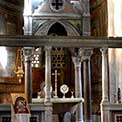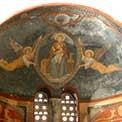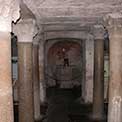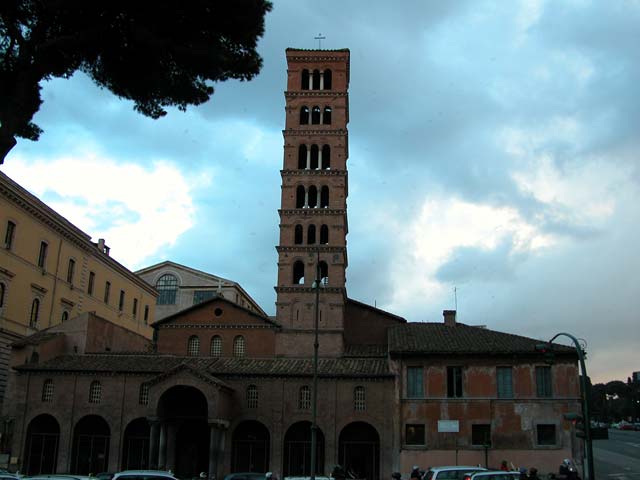
This most interesting of the smaller Roman basilican churches, built within a temple, was founded by Adrian I. late in the eighth century, and rebuilt under Calixtus II., about 1 128, by Alfanus, Chancellor of the Papacy, whose marble tomb stands in the atrium with his epitaph, along a cornice, giving him that most comprehensive title " honest man," vir probus,* some more than halffaded paintings, a Madonna and Child, angels and two mitred heads on the wall behind the canopy, conferring importance on the tomb of this Chancellor.
Though now disfigured exteriorly by a facade in the worst style of the eighteenth century, Sta Maria in Cosmedin, t since the judicious restoration of its interior, is one of the mediaeval gems of Rome, and retains many fine details of its earlier architecture; the Classic colonnades imbedded in the walls of the north aisle and the west end, and probably left in their original place since the time of Adrian I., and (of the twelfth century) most noticeable among all, that fine campanile, one of the loftiest and most picturesque in Rome, which is so often seen in views of the neighbouring church of Sta Maria del Sole.} The sculptured doorway, the rich intarsio pavement, the high altar with its charming spiral ciborium, the marble and mosaic-inlaid ambons and open screens (a most perfect example of restored mediaeval Roman choral arrangement), the marble episcopal throne with supporting lions and a mosaic decoration above, in the apse, etc., deserve the warmest admiration. The destruction of the mediaeval paintings by whitewash in the wall surfaces is to be deeply deplored. These paintings were known to have adorned them conformably to that ancient and once almost universal practice of polychrome decoration in churches which was even prescribed by a law of Charlemagne.
Ciampini, in his valuable history of the Cosmedin basilica, mentions the iron rods for curtains once seen between the columns of the atrium and still in their place above those of the porch, with rings for suspending; also a small chapel, like a recess, at one end of that atrium with paintings of the Madonna and Child, the symbols of the Evangelists, and so on. This chapel would seem to have been provided for those penitents who were not allowed to worship with the congregation in the sacred building; as such it is an evidence of disciplinary observance, retained till the twelfth century, the loss of which is a matter for regret.
Over the portals are some curious bas-reliefs, but so small, and placed as they are along the inner side of the lintel, that they might be passed unnoticed by the casual observer. In the centre is a hand blessing, with the Greek action, between two sheep, who represent the faithful; laterally we see the four evangelic emblems, all winged, and two doves, each pecking out of a vase, and one perched on a dragon (more like a lizard) to signify the victory of the purified soul over mundane temptations or passions.
Another such example of such mystic sculpture over a church portal, and probably of the same period, is at Sta Pudenziana (restored in 1130), where, above the chief entrance, are bas-reliefs of the Lamb, with cross and nimbus; the daughters of Pudens, SS. Praxidia and Pudenziana, holding vases filled with martyrs' blood, and two males, each with a scroll and a book in his hands; these latter represent the converted senator Pudens and St Pastor, brother of Pope Pius I., to whom this church was once dedicated, conjointly with that senator's daughter.
The interior of Sta Maria in Cosmedin, since the restoration of its ancient chorus and screens, and the removal of much tasteless baroque " embellishment," is one of the most engaging of the basilican type in Rome. It comprises a nave and aisles, and a round-ended apse to the former. The arcades are remarkable, being divided, on each side, by solid mass piers into three compartments of four and three bays each. Upon entering there are four round arches and then a pier; then four more arches and a pier; and again three similar arches to the end.
The columns, all antique, are diverse in size and style, some fluted, some plain. There is a considerable wall space between these arcades and the clerestory, which presents a series of small round-headed windows, close under the roof which has been restored to its old form.
The floor is entirely paved with mosaics, in which, however, some ancient inscriptions are worked up. The altar stands westward of the apse under a Pointed baldachino; the tribune (reaching as far westward as the first masspier) is raised three steps, and the chorus cantorum, whose screens are continued across the aisles, extends further west into the nave, one step high, until lately, without any wall or fence, but with an ambon on each side. A view of the interior of Sta Maria in Cosmedin, as it appeared before the restoration of the old chorus, and showing these ambons isolated on either side of a slightly-raised floor, is given by Gailhabaud in his Monuments anciens et modernes.
The ambons are just as in San Lorenzo: i.e., the Epistleambon, a square pulpit with a book-desk facing east, is on the north side of the church; the south side, however, of the altar faces west. The Gospel-ambon, on the opposite side, is an octagonal pulpit, facing sideways, with two flights of steps on opposite sides and a paschal candlestick, which is as usual a spirally-twisted column with mosaic ornaments. There is another spiral column ornamented with mosaic work, in the apse, to the right of the pontifical chair, which has its arms carved in lions. The baldachino, which figures in Gailhabaud's drawing, has four classical columns sustaining a Pointed canopy with a trefoiled arch on each side; angular pinnacles, and a small quadrilateral open niche at the top, surmounted by a cross. This canopy is groined quadripartitely inside from small vaulting shafts which rise from the capitals of the larger columns; the vault being domical with the ribs meeting in a small boss.
The altar underneath it has an ancient mensa of white marble upon a porphyry sarcophagus.
To the south-west is the very fine Roman campanile already alluded to; square, of brick, with a tall plain basement and then seven low stages. Of these the lower two have two windows on each side, and the other five three windows on each side, divided by shafts, but the fourth stage from the top has been altered.
THE CATHEDRALS AND CHURCHES OF ROME AND SOUTHERN ITALY By T. Francis Bumpus.
LONDON - T. WERNER LAURIE - CLIFFORD'S INN

